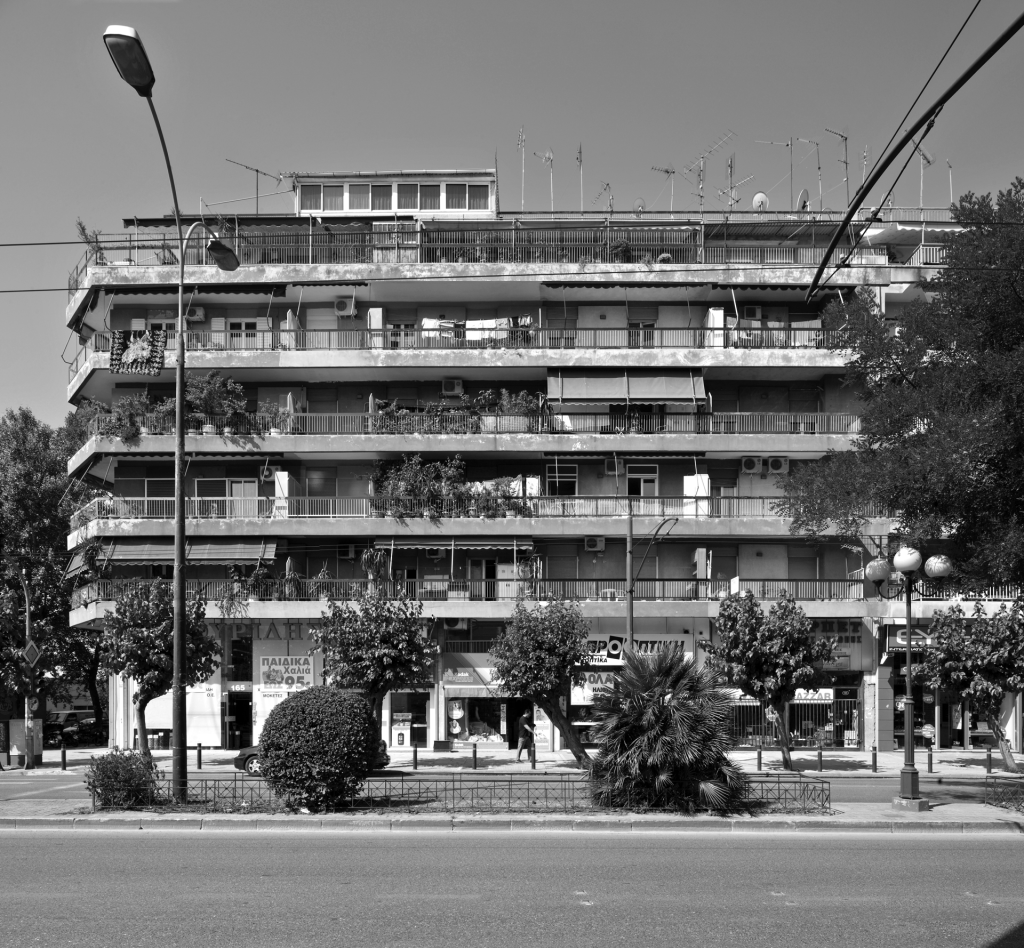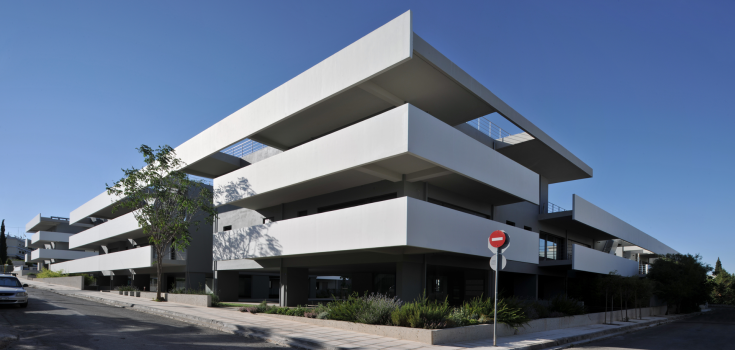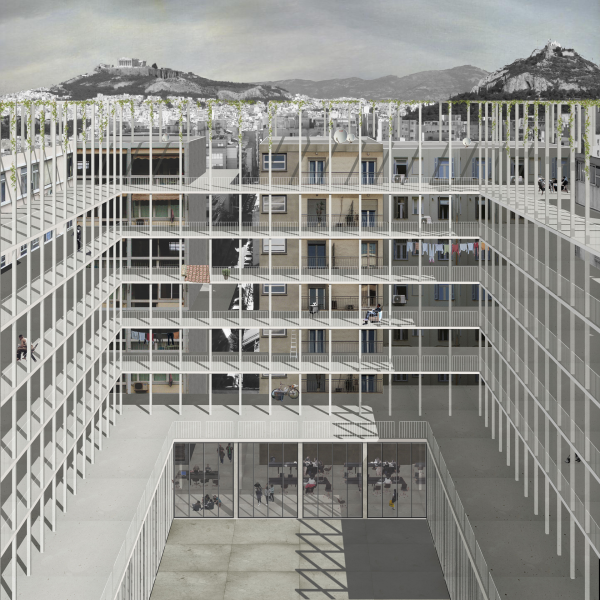Design Adventures in Ad-Hoc Urbanism: Mapping the Connections between Construction Industry, Real Estate and Modern Architecture in Greece
Essay by Panos Dragonas published in Archithese 04.2014 (August 2014), pp.74-81.

Fig. 1. Typical view of Athens, photo from the Athens Spread series, 2012 (Photo: ©Yorgis Yerolymbos)
In light of the current economic crisis, Greek society, the city and the conditions of the real estate market are undergoing transformation. Apart from the establishment of new relationships between government, private companies and the building industry, this has also led to a social polarization of contemporary Athens.
Construction industry has been the major pillar of the Greek economy throughout the 20th century. The connections between construction industry and the housing market have been very strong in Greece. New housing has been the main product of building activity until the turn of the century. In order to understand the way the real estate market functions in Greece, one should take into account certain particularities in the development of the Greek cities. These are mostly connected with the role of the State and the evolution of the construction industry. There are also certain moments in modern Greek history when major population changes have decisively affected the development of the cities, such as the arrival of refugees from Asia Minor in 1922, the internal immigration from the Greek countryside after World War II, the arrival of economic immigrants from Eastern Europe in the 1990s, and, finally, the emigration of highly educated Greek people after the outburst of the recent economic crisis.
THE BOTTOM-UP DEVELOPMENT OF THE GREEK CITY
The post-war development of the Greek cities has resulted in the urgent demand for employment and housing by the population that migrated from the countryside to the urban centers. The urban development offered plenty of job opportunities in the newly formed construction industry. The reconstruction of the cities has driven the booming economy and has contributed to the social formation of the middle-class in Greece. (1)
Contrary to most European countries, the Greek state has not been involved in post-war urban reconstruction. There is only a limited number of examples of social housing in Greece. Urban planning has been deficient and in most cases it followed the ad-hoc need for expansion of urban areas. The development of the Greek cities was based on a property-swap system that allowed the collaboration between land owners and developers. The high segmentation of land in the Greek cities encouraged the building activity of small-sized construction companies. These were founded by self-taught contractors who hired inexperienced workers from the countryside. This particular collaboration between the owners of small pieces of land and the improvising contractors benefited from tax privileges and subsequently allowed the informal development of the Greek cities from the bottom up. (2)
The main unit in the development of the Greek cities has been the building type of polykatoikia (apartment building). The concept of the polykatoikia is based on the Dom-ino system that was introduced during the Interwar years in Greece. A simple concrete structure with a central staircase and an elevator shaft allows for the flexible arrangement of domestic spaces and public facilities. However, in most cases the polykatoikia were not designed by architects, but by civil engineers or even the contractors themselves. (3) The design of polykatoikia obeys a set of basic rules, which were imposed by the informal real estate market, the construction technology and the building regulations, and could be easily applied by any engineer or draughtsman.
Land speculation has been the driving force in the urban development of the Greek cities. The main target of design was the maximization of the building surface and subsequently of the contractor’s profit, very often in excess of the building regulations. Building surface area was more important than the architectural qualities. Subsequently, the design outcome has been generic with no design ambitions. Nevertheless, this generic architecture of the polykatoikia has been appraised as an important asset of the Greek city. The flexibility of the typical plan has allowed for the successful mix of private and public programs in the typical apartment block. Furthermore, the monotonous repetition of the typical units has produced a non-hierarchical urban environment that used to absorb most cultural and social differences. It is important to notice that the increasing social polarization in Athens has coexisted with low levels of urban segregation throughout the 20th century. (4)

Fig. 2. Typical Apartment building polykatoikias in Athens, photo from the Athens Archive series, 2012 (photo: ©Charalambos Louizidis & Aikaterini-Niki Glinou)
THE EMERGENCE OF CONSUMERIST LIFESTYLE
By the turn of the century, the social and economic conditions were very solid in Greece. The country’s participation in the European Currency Union allowed cheap borrowing from the international markets. At the same time, the arrival of economic immigrants from Eastern Europe offered cheap labor for the implementation of construction works for the Olympics. For one more time, it was the construction industry that led to an economic boom. Contrary to the post-war period, the economic growth was not led by the self-taught contractors, but by a well-established industry that was implementing large-scale infrastructure works in Greece and abroad.
The prosperity of this period increased the demands of the urban population for a better quality of life. New lifestyles were introduced in the Greek cities that emphasized well-being. The newly formed middle-class succumbed very quickly to the ideology of consumerism. A new subject was shaped by the mass media and the market around the dominant consumerist lifestyles. (5) The architects were involved in this bio-political transformation through the commodification of design. Residential architecture, interior design and high-quality furniture were promoted by mass media as symbols of prosperity and well-being.
The new Metro network and the ring-road of Athens allowed the construction of shopping malls and leisure activities at the periphery, which soon deserted the traditional downtown market areas. The city was diffused along the major infrastructure works, (6) through the creation of beautifully designed suburban villas and vacation houses along the Attica coast. The vast majority of the new suburban houses were funded and commissioned by the owners themselves and were designed and supervised by small-scale architecture firms.
The first connections between the upgraded construction industry, the newly formed real estate market and the local architecture scene occurred soon after the Olympics. A milestone in this development was an open architectural competition for the design of a model apartment complex at a central neighborhood of Athens that was organized by a major construction company and the newly founded architectural review Domes in 2006. (7) The results received wide publicity and the selected design by Ioannis Papadopoulos and Georgia Daskalaki was soon implemented, highlighting the shift of interest of the construction companies back to housing. This initiative was one of the most serious attempts to overcome the dominant model of polykatoikia. It was soon followed by similar projects, which have been highly appraised for their design qualities, such as the residential complex “Uptown” next to the Athens Ring-road by blp architects; the “One Athens” residential complex by Divercity architects, the regeneration of an emblematic modernist building designed by Constantinos A. Doxiadis; “Oyster Smart Flats” by ISV Architects which offered a wide range of amenities and services; “Thission Lofts” and “My Loft” by if_Untitled Architecture which were the first attempts to regenerate industrial buildings through residential programs.
The 2000s were the period of a paradigm shift for housing in Greece. It was then that the construction industry and the housing market matured and engaged highly capable Greek architects for various projects. On the other hand, this was the period when architectural design became a commodity, following the demands of a society that lived well beyond its limits.

Fig. 3. Atelier Bow Wow:Kerameikou Street Apartment for KM Properties, 2012 (image: Atelier Bow Wow)

Fig. 4. Georgia Daskalaki, Yannis Papadopoulos,: Residential and Commercial Complex in Metaxourgeio, Athens 2007-2009 (Photo: ©Charalambos Louizidis)

Fig. 5. Iro Bertaki, Christina Loukopoulou, Costis Paniyiris: Uptown Residences, Apartment Building Complex in Maroussi, 2006-2012 (Image: Bertaki, Loukopoulou, Paniyiris)

Fig. 6. ISV Architects: Oyster Smart Flats, Athens 2013 (Photo: ©Argyris Mougiakos)
THE RETURN TO THE CITY CENTER
During the last ten years, there are different groups of the younger population that have returned to the city center and have claimed back the public space of Athens.
On the one hand, there is the newly formed creative class, consisting of young, well educated workers in media, in design and culture, which appeared in Athens during the years of the economic boom. Contrary to their parents, who chased the dream of moving to the suburbs, these young people have been attracted by the qualities of the abandoned city center, such as the modernist architecture, the vitality of the mixed uses and the diversity of the population. On the other hand, there are many self-organized radical groups, grassroots movements and collectivities with different aims, such as the protection of the open urban spaces from privatization plans or the support of immigrants and homeless people. Most of these groups appeared at the aftermath of the massive 2008 riots, which manifested the younger generation’s anger against the dominant ideals and consumerist lifestyles of the 2000s. (8)
The winter of 2008 was another milestone in the recent history of Athens. Since then, several top-down and bottom-up initiatives have occurred in order to claim back the city centre. The newly formed Ministry of Environment and the Organization of Planning and Environmental Protection of Athens have showed strong support of the notion of the “compact city”. “Rethink Athens” -the most emblematic project for the regeneration of the city centre across Panepistimiou Street which was organized and funded by the Onassis Foundation- was initiated at this time. “KM Properties”, an ambitious program for the urban regeneration of a central neighborhood, was announced by a private company. (9) At the same time, there were serious attempts to reclaim public space through bottom-up initiatives by the new grassroots movements that unfolded in public space. Among them, the best known example is the Navarinou park at Exarcheia, which has been constructed, organized and managed by a committee of neighborhood residents.
The return to the city centre by conflicting stakeholders, such as the private investors and the grassroots movements, has been a very interesting development for Athens. New strategies of urban regeneration have been unfolded, as for example in the KM properties area where an art festival is organized every year in order to attract young creative people in the area. New housing typologies have been investigated, as in the architectural competition “Up to 35” for student dorms in Metaxourgeio. New types of co-working spaces have appeared in the services of start-up companies and artist’s collectivities, as for example in the former printing plant of “Romantso” magazine next to Omonoia square. New ideas are being spread through design research by local and international schools of architecture that often visit the city, as for example in Berlage Institute’s research on the potential of the Athenian polykatoikia to accommodate urban commons. (10) One would expect another paradigm shift during this period. Unfortunately the collapse of the economy has not allowed the conclusion of these initiatives. Nevertheless, their dynamic has not been lost.

Fig. 7. Divercity & Trac: Conversion of Doxiados Office Building- ATI to Apartment Building, contribution for “ONE Athens”, 2007-2009 (Image: Divercity & Trac)
THE THREAT OF URBAN SEGREGATION
Since 2010, the structural adjustment of the Greek economy has been implemented under the Troika regime. The austerity that is imposed by the dominant neoliberal policies has suspended most building activity. The tax reformation has hit the real estate property and let to dropping property prices. As a result, both the construction industry and the real estate market have collapsed. The lack of liquidity favors large investors who are taking advantage of the program of privatizations of public assets.
The Greek society is under transformation as the middle-class is threatened by the austerity measures. Many highly qualified employees emigrate to the US, Canada and Australia. In addition to this, there is ideological polarization between liberalism and the radical left. On the one hand there is uncritical support of any private investment plan that may reduce the country’s debt. While on the other hand, there is total neglect of any involvement of the private domain in projects of public interest.
The most controversial example is the investment plan for the former airport of Athens. “Ellinikon” is a 5,300 acres site at a privileged coast area that was intended to become the new Metropolitan Park of Athens. However, after the outburst of the economic crisis, the whole area was given to private investors under the obligation to create a much smaller park, among high profile residential developments and other commercial and leisure facilities.
One of the requirements for the investors that participated in the bid for Hellinikon was the collaboration with a Pritzker laureate. Recently, it was announced that Sir Norman Foster has been appointed for the architectural undertaking of one of the largest development plans in the world. Up to this moment, the brief presentation of the initial scheme does not allow for a comprehensive critical review. However, there are serious concerns that a residential development at a privileged part of the city may intensify the social segregation in urban space. Contrary to the monotonous, low-segregated, urban space of the post-war development, the social polarization of contemporary Athens is reflected on the urban space, which includes poor neighborhoods for the immigrant population and high profile areas for the economic elite.

Fig. 8. OKRA Landscape Architects (in collaboration with Mixst Urbanism, Wageningen University, Studio 75, Werner Sobek Green Technologies): contribution for “Rethinking Athens” architectural competition, First Prize, 2013

Fig. 9. Self-managed Park at the corner of Navarinou and Zoodochou Pigis
DESIGN FOR THE COMMON GOOD
The evolution of housing architecture in Greece has followed the development of the social and economic conditions. The design paradigm has changed in accordance to certain milestones in the history of the country.
The post-war reconstruction was based on the repetition of the basic housing unit of the polykatoikia. Despite the banality of the architectural design, the generic model of the polykatoikia has been a successful response to the urgent demand for housing. The flexibility and the small-scale of the typical Athenian apartment unit allowed for the mix of uses in the Greek city and subsequently for the creation of a vivid and intimate urban environment.
At the turn of the century, the economic growth and the demand for a higher quality of life created the conditions for the development of prestigious residential projects. Highly skilled Greek architects grasped this opportunity in order to produce single houses and apartment complexes of high architectural quality in the services of the upper middle-class and the economic elite.
After the outburst of the crisis, there has been a shift of interest towards the problems of the city, emphasizing the contemporary issues of sustainability, rehabilitation and social diversity. There have been clear indications that architectural and urban design has regained its social orientation. However, the imposed austerity measures have not allowed the implementation of most initiatives. The urgent demand to reduce the country’s debt has given priority to the exploitation of public assets. It remains doubtful whether the involvement of internationally renowned architects may compensate for the lack of an overall strategic planning in the development of the public properties.
The recent history of Greek architecture, examined in the broader context of the social and economic transformations, shows that high design quality is not sufficient in order to build socially sustainable cities. Highly capable architects are often exploited by the real estate market through media exposure and by the commodification of design. Whereas generic architecture and informal development may properly serve the common good.

Fig. 10. J. Hyun Woo: Cloister, Metaxourgeio, Athens. Thesis studio project at the Berlage Institute, 2010-2011. Tutors: Pier Vittorio Aureli, Maria Shéhérazade Guidici, Platon Issaias (image: domus)
